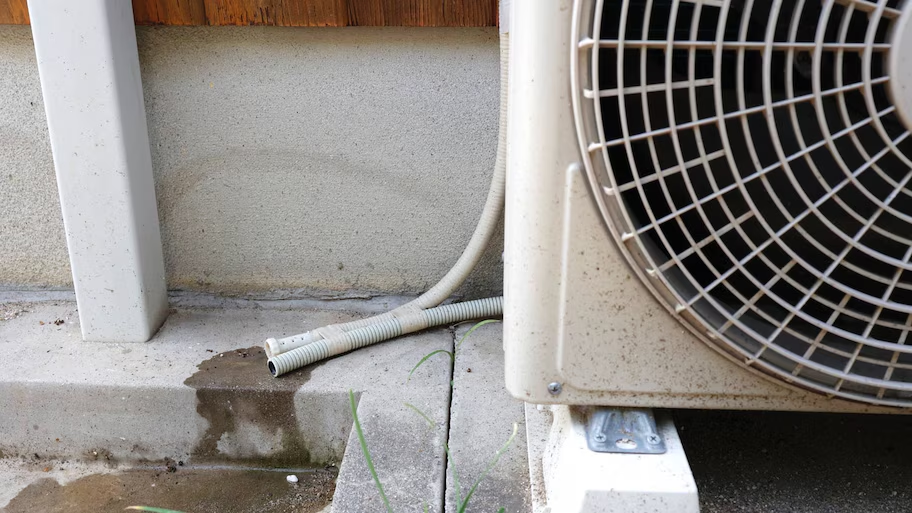Tools for Cleaning Drain Lines:
One of the most vulnerable places for slime accumulation is the condensate drain line. Slime can eventually choke the line, causing water leaks and possibly damaging neighbouring structures. Blockages can be successfully removed with cleaning equipment like pressurised air guns, flexible drain snakes, and wet/dry vacuums. While drain snakes scrape away persistent build-up, wet/dry vacuums can draw out dirt and sludge. Pressurised air can clear obstructions in difficult-to-reach places, keeping the queue clear and operational. Water damage and system inefficiencies can be avoided with routine maintenance that uses these techniques.
Chemical Procedures:
One of the best ways to fight AC slime is with chemical remedies. By eliminating bacteria, mould, and algae, algaecides and biocides deal with the underlying problem. Long-term protection is guaranteed by these chemicals, which not only clean but also prevent further growth. Condensate lines are frequently cleaned at home using vinegar and diluted bleach, but specialised HVAC cleaning solutions are frequently safer and more efficient for the system. Applying these chemicals on a regular basis helps keep slime at bay and preserves the effectiveness of your air conditioning system.
Condensate Pan Maintenance:
Slime accumulation can also occur in the condensate pan, which gathers water from the cooling process. Slime cannot spread into the drain line if this pan is cleaned on a regular basis. Maintaining the pan’s cleanliness and preventing microbiological development requires using a brush or sponge to scour it and then applying a disinfectant. Another good protective measure is to install condensate pan tablets. With little effort, these slowly dissolving pills maintain the pan clean and slime-free by releasing biocides gradually.
UV Light Systems:
Microbial development in HVAC systems can be effectively controlled with UV light systems. These devices, which are placed close to the evaporator coil, release UV light that ruins the DNA of bacteria, algae, and mould. UV lamps stop slime build-up by removing the slime’s initial source. They are a long-term treatment that reduces airborne pollutants and eliminates existing slime while also enhancing indoor air quality. UV light systems are a worthwhile investment due to their efficacy and ease of maintenance, even though the initial installation cost may be higher.
Steam Cleaning:
Slime may be effectively and environmentally removed from coils and other parts with steam cleaning. Without the use of harsh chemicals, high-temperature steam eliminates algae, mould, and germs. Cleaning evaporator coils, which are susceptible to slime accumulation because of their continuous exposure to moisture, is made easier with this technique. Steam cleaning lowers energy usage and increases cooling system performance by getting rid of slime and other impurities.
High-Pressure Jetting of Water:
An efficient method for removing tough slime from condensate lines and other AC parts is high-pressure water jetting. This technique breaks apart and removes debris, algae, and slime that have accumulated over time using a strong jet of water. For systems with substantial obstructions or extensive plumbing, high-pressure jetting is particularly helpful. It’s important to take care that the pressure doesn’t get too high and harm the parts. Professionals with the appropriate tools and knowledge are most suited to use this technique.
Use of Enzyme-Based Cleaners:
Cleaners based on enzymes are a very efficient and environmentally pleasant way to get rid of AC slime. Without the use of harsh chemicals, these cleaners’ natural enzymes decompose organic materials like bacteria, mold, and algae. Enzyme-based treatments help clean and stop slime growth by breaking down the ingredients that make it. These cleansers are a great option for homes looking for a non-toxic maintenance solution because they are safe for HVAC components. Frequent application guarantees optimal system performance and keeps slime at bay.
Thermal Fogging:
Thermal fogging is a specialized method that creates a thin mist of disinfectants and cleaning chemicals by using heat. Slime in hard-to-reach places, like ducting and concealed compartments, responds well to this technique. Every part of the system is penetrated by the fog, which kills germs, mold, and algae while leaving a barrier to stop further growth. By removing airborne pollutants, thermal fogging enhances interior air quality in addition to getting rid of slime. The ideal people to do it are experts with the right tools and knowledge.
Installing Antimicrobial Coatings:
Important parts like coils, drain pans, and other surfaces that are prone to slime accumulation can be coated with antimicrobial agents. Agents in these coatings actively prevent the formation of bacteria, algae, and mold. Once sprayed, the coating reduces the likelihood of slime development by forming a long-lasting protective barrier that inhibits microbial growth. For systems in humid settings or places where routine maintenance is difficult, this method is very helpful.
Using Camera Tools for System Inspections:
Slime accumulation in difficult-to-reach places of an air conditioner can be found and evaluated using contemporary camera inspection equipment. These instruments have flexible cameras that can move through ducts and drain lines to provide real-time images of obstructions and slime build-up. Early problem identification allows you to take care of problems before they end up out of hand. Using camera tools for routine inspections can also help plan future maintenance schedules and verify the success of cleaning operations.
Professional Maintenance:
Even though do-it-yourself tools and methods work well, professional maintenance offers a more thorough and comprehensive method of dealing with AC slime. To guarantee that every component of the system is clear of slime and debris, HVAC experts have access to cutting-edge equipment and cleaning solutions. They can also find and fix underlying problems that could be causing slime build-up, like poor drainage or airflow concerns. In addition to keeping slime under control, scheduling yearly professional maintenance guarantees your system runs effectively and dependably.


